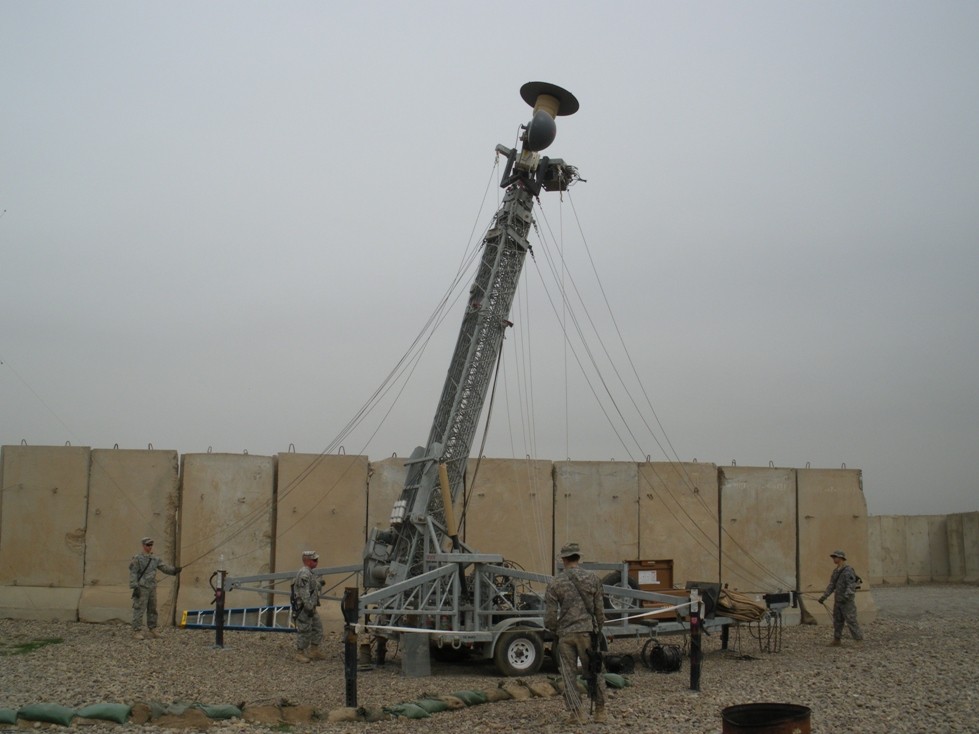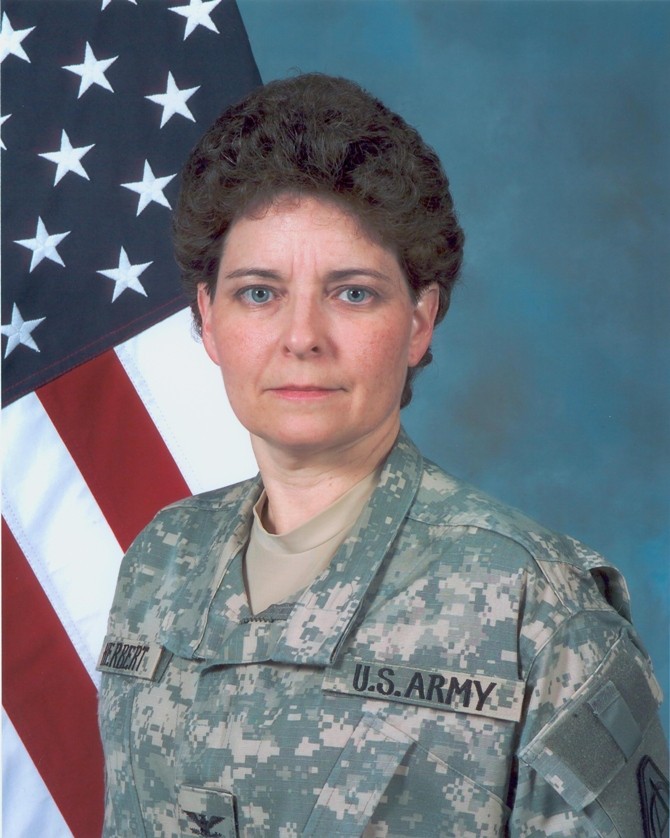FORT MONMOUTH, N.J. -- Recent wars have ushered in a totally new way of conducting operations: coordinated sensor warfare.
Whether the area of focus is Base Defense, Air Defense, Intelligence, Reconnaissance, Target Acquisition, or Target Prosecution, timely and actionable information is essential. A robust way to accomplish this is through a cogent networking of different types of sensors.
The Project Manager, Night Vision/Reconnaissance, Surveillance, and Target Acquisition (PM NV/RSTA) has fielded networked sensors in theater since 2002 and continues to evolve and improve this critical capability.
PM NV/RSTA's sensor systems enable our warfighters in theater to rapidly and effectively respond to evolving threats thereby saving lives on the battlefield and advancing the overall mission.
"The Base Expeditionary Targeting and Surveillance Systems - Combined (BETSS-C) is an exemplar of the state-of-the-art ISR and Force Protection (FP) technologies required to effectively support the 21st century warfighter," said Col. Linda R. Herbert, project manager, PM NV/RSTA. "BETSS-C represents a fully-integrated, operationally-relevant ISR and Force Protection capability that provides the warfighter with integrated views of multiple points of situational data."
BETSS-C, Central Command's (CENTCOM) number two priority, comprises a combination of ISR, battle command, and Force Protection systems (Rapid Aerostat Initial Deployment (RAID) Towers, Cerberus Towers (CERBERUS), the Force Protection Suite (FPS), and the Rapid Deployment Surveillance Security System (RDISS))
Each system provides specific capabilities to address critical warfighter needs. RAID and CERBERUS address targeting and surveillance needs (detection of people and vehicles), enabling persistent day and nighttime targeting and surveillance data.
The FP suite of systems (a family of cameras integrated into a common operational picture) addresses persistent surveillance and standoff detection needs. Finally, the RDISS suite of systems (a suite of sensors for perimeter and entry point security) addresses security monitoring and surveillance needs. BETSS-C represents the integration of these capabilities, creating a networked source of actionable information.
"Moreover, BETSS-C also represents the culmination of several best practices for effectively managing a Quick Reaction Capability (QRC), as we were expected to field before the close of 2008 - - a very aggressive timeframe," Herbert emphasized.
BETSS-C Gets its Start: An Integrated JUONs for a "System of Systems"
The concept for what would ultimately become BETSS-C arose in the summer of 2007. "There were multiple Joint Urgent Operational Needs Requests (JUONs) coming from theatre requesting various separate, but very much related ISR and FP needs," said Robin Whitworth, deputy project manager, PM NV/RSTA.
CENTCOM recognized the connections among the multiple JUONs and recommended a somewhat new approach including integration of the JUONs and, in response to them, the development of a "system of systems" for targeting and surveillance capabilities to support the warfighter.
"Integrating the JUONs was helpful, but it also increased the complexity of the ultimate system," said Raef Schmidt, technical director, PM NV/RSTA. "Our first objective was to break down the requirements to build an understanding of them and to then match solutions to the requirements to ensure a seamless fit," concluded Schmidt.
This time and rigor was channeled and managed in a specific approach that PM NV/RSTA developed and employed to effectively manage the BETSS-C QRC. Tom Conway, systems engineer and technical lead for PM NV/RSTA, described the approach in terms of related, progressive stages:
"We approached management of this QRC in three stages: the set-up stage (first six to eight months), the structure stage (next nine months), and the maintain-and-improve stage (approximately 17 months into the QRC) to bring more focus to our efforts and to pursue clearly articulated objectives at each stage."
Tony Budzichowski, project lead for BETSS-C, added, "The fruits of this approach are clear - - BETSS-C was fielded on time and within budget and it continues to provide the warfighter with integrated, operationally-relevant data."
A Staged Approach: Building Best Practices for QRC Management
One of the core activities included in the set-up stage was the development of a concept of operations (CONOPS). The CONOPs provided a feasible, effective means of "getting closer" to the customer (the warfighter) to understand, at a certain depth, needs and intended experiences with the product. "The CONOPS helped us to keep the warfighter at the center of all of our efforts to ensure that we would ultimately field a system that performed in the way the warfighter needed it to," added Schmidt.
PM NV/RSTA also looked inward to determine whether and to what extent its proven RSTA systems may help to address the warfighter's needs. "We asked ourselves which of our systems may be well-positioned to address particular requirements in the JUONs," Schmidt added.
"We found that several of our systems demonstrated a variety of the system requirements we derived from the JUONs. However, we then needed to integrate them in a way that was meaningful and technologically sound. We wanted our end result to be integration, not just simply plugging disparate systems together," Schmidt said. In this manner, PM NV/RSTA matched system requirements with existing solutions, where possible, saving precious time and resources in doing so.
Once the program was established and defined, PM NV/RSTA entered stage two, the structure stage, in which it engaged in a rigorous, methodical approach to systems engineering including a multi-pronged strategy spanning several key areas, including people and processes. Because of the time invested in decomposing the requirements from the integrated JUONs, PM NV/RSTA was well-positioned to understand the kinds of resources and skill sets required to meet its needs. "We knew we needed strong resources who were experienced with these kinds of integrated systems and had worked with them in theatre," said Schmidt.
PM NV/RSTA also recognized that it needed the right processes in place to do the job well. "Having the right resources is important," Conway explained, "but enabling them to do their job by having the right processes is as important." As such, PM NV/RSTA standardized systems engineering processes, focusing on employing best practices and adapting them to meet the specific needs of the BETSS-C program and the culture within the PM. "We standardized where it made sense, and we allowed flexibility where it made sense, " Schmidt added.
PM NV/RSTA also implemented a milestone-oriented, requirements baselining process to ensure that all requirements were not only captured, but could also be traced directly back to customer needs. "By performing baselining activities at set intervals throughout our systems engineering processes, we were able to quickly identify potential gaps and then realign ourselves without sacrificing time or progress," said Whitworth. PM NV/RSTA also leveraged technology that enabled them to log all requirements and to trace each to specific customer requirements.
Up and Running: BETSS-C at Work in the Field
Having adopted a full lifecycle approach to managing BETSS-C, PM NV/RSTA had its eyes on fielding and sustainment at the earliest stages of the QRC. "We knew we had an aggressive fielding schedule, so we were planning from the start and we began executing on our plans during the third stage of managing this QRC, 'maintaining and improving'," said Herbert.
This entailed understanding fielding requirements early on, establishing the requisite channels for fielding, and determining and executing on critical sustainment needs (e.g., operator training, provision of field service representatives (FSRs), and hub-structure operations).
The PM also oversaw in-depth CONUS training for operators and FSRs to ensure that both had the skills required to fully leverage BETSS-C's capabilities. "We didn't want a situation where the systems were not being used to the fullest extent because of a lack operator skills, or that the systems were not consistently maintained due to the learning curves of FSRs," Schmidt explained.
"Now that we are solidly in the third stage of managing this QRC, we are increasingly focused on improvement - - how can we improve BETSS-C as a system' - - how can we improve our sustainment operations' - we continuously ask ourselves these kinds of questions and then work to implement the best solutions" said Herbert.
Returning from a recent trip to Afghanistan, Herbert observed sustainment operations firsthand: "One of the things we are looking at more closely is our FSRs and whether we have the right number and alignment of staff to sustainment hubs. Leveraging the Lean Six Sigma methodology, as well as modeling and simulation analytics, we are in the process of developing a predictive model. The model will help us continue to make data-driven sustainment decisions by enabling simulation of myriad situations that occur in theatre in a low-risk and cost effective manner," Herbert explained.
Looking Ahead: The Future Of BETSS-C
BETSS-C is critical to the success of U.S. efforts in Afghanistan. In fact, because of the challenging and diverse geography within the region, ISR and FP capabilities are proving increasingly critical to providing the warfighter with reliable, integrated, and actionable information.
"I see BETSS-C continuing to play an integral role in providing state-of-the art ISR and FP capabilities in support of the fight in Afghanistan," said Herbert.
"Furthermore, as we continue to engage our coalition partners, developing the capability to integrate coalition forces' ISR and FP capabilities with our own will become increasingly relevant and central to our success. BETSS-C can serve as at least one template for this kind of cross-coalition integration of systems," she added.
Today's Army is continuously seeking and developing ways to leverage existing and new technologies to improve warfighter survivability and lethality. BETSS-C is an example of this way of thinking and approach. By providing integrated, state-of-the-art ISR and FP technologies, BETSS-C is contributing to the process of saving lives and enabling combat overmatch on the battlefield everyday.




Social Sharing